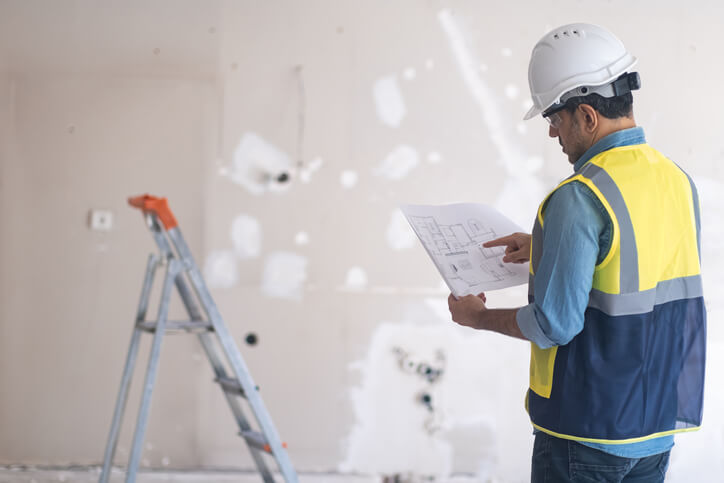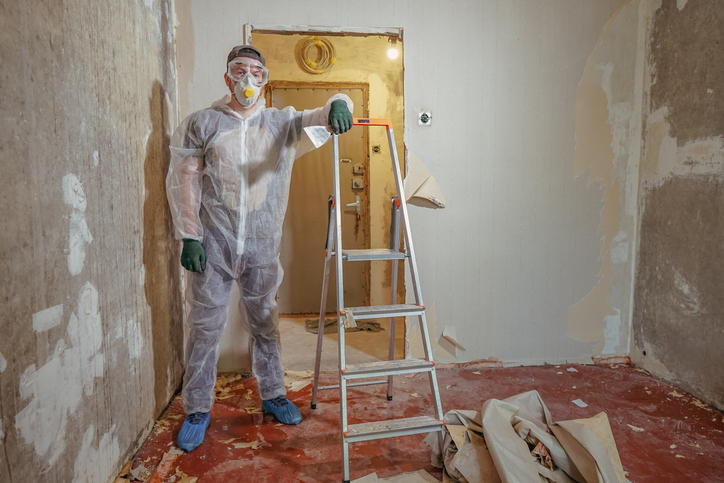Category: Home Renovation
Considering Home Renovation Training? 3 Tips for Planning a Seamless Project
March 05, 2024
A home renovation project is a serious undertaking. Often, it requires a significant outlay in resources, skills, and effort; therefore, it’s not something to dive into unprepared.
When handling home renovation projects, failing to plan well in advance means planning to fail. Whether you’re a budding DIY enthusiast or considering a home renovation and construction career, understanding the fundamentals of planning and executing renovation projects is crucial. For those contemplating home renovation training, here are three essential tips to help ensure your projects are successful, seamless, and stress-free.
1. Home Renovation Training Emphasizes That Comprehensive Planning Is Key
Understand Your Goals: A clear understanding of your end goals is essential before diving into any renovation project. Are you looking to increase the home’s value, make it more energy-efficient, or simply update the aesthetics? Your objectives will significantly influence the project’s scope, budget, and timelines. Home renovation training equips you with the skills to assess a project from multiple angles, ensuring your plans align with your goals.
Create a Detailed Plan: A well-thought-out plan is the backbone of any successful renovation project. This includes detailed drawings or plans, a clear list of all required materials, and a step-by-step guide to the renovation process. Training in home renovation provides the technical knowledge necessary to create comprehensive plans, helping you anticipate and mitigate potential issues before they arise.
Set a Realistic Budget: One of the most common pitfalls in home renovation is underestimating costs, leading to budget overruns and incomplete projects. During your home renovation training, you’ll learn how to accurately estimate costs, including materials, labor, permits, and unexpected expenses. Setting a realistic budget and having a contingency fund can save you from financial stress.

2. Acquire the Right Skills and Knowledge
Learn From Experts: Home renovation training offers the opportunity to learn from experienced professionals. These experts can provide insights into the industry’s latest trends, techniques, and materials. Additionally, they can teach you how to use tools and equipment safely and efficiently, which is invaluable for DIY projects and professional endeavors.
Understand Building Codes and Permits: Navigating the legal requirements of home renovation projects can be complicated. Home renovation training provides an understanding of local building codes, zoning laws, and permit requirements, ensuring your project complies with all regulations. This knowledge will prevent legal issues and ensure the safety and longevity of your renovation work.
Focus on Sustainable Practices: Sustainability in home renovation is increasingly important. Home Renovation Training can introduce you to eco-friendly materials and practices, helping you make informed choices that benefit the environment and can also reduce long-term costs for homeowners.

3. Effective Communication and Project Management Are Essential When You Become a Renovation Technician
Develop Strong Communication Skills: Effective communication with clients, contractors, and suppliers is vital to the success of any renovation project. Home renovation courses often include project management principles, teaching you how to convey ideas, negotiate contracts, and resolve conflicts. These skills are essential for keeping projects on track and ensuring all stakeholders are satisfied with the outcome.
Learn to Manage Time and Resources Efficiently: Time management is critical in home renovations, where delays can lead to increased costs and dissatisfaction. Training programs provide strategies for scheduling work, coordinating with contractors, and managing resources efficiently. This ensures projects are completed within the allocated time frame and budget, with minimal waste.
Do you want to become a renovation technician?
Contact NATS for more information.

Material estimation is a key skill for anyone involved in home renovation. It’s a skill that ensures projects stay on budget and on time. As such, it requires precision, foresight, and an understanding of both the project at hand and the materials involved.
For students who have completed home renovation training, mastering material estimation is crucial for successful project management and cost control. This blog post highlights the best practices for material estimation and offers guidance to those new to the field, drawing from expert advice and industry standards.
Understanding Material Estimation
Material estimation is more than just a list of items needed for a project. It involves a detailed analysis of the required materials’ quantity, type, and cost. A reasonable estimate prevents resource wastage, ensures budget adherence, and can influence a renovation project’s overall design and implementation.
As you’ll discover in home renovation training, material estimation is a crucial process in construction and renovation projects. It involves a detailed calculation of the quantity and cost of materials required for the successful execution of any project.
The process begins with a clear understanding of the project scope, which includes the specifications and dimensions of the construction. Estimators calculate the materials needed, factoring in the square footage and specific project requirements. They then determine the cost of these materials, considering current market prices and potential fluctuations.
This estimation is vital for budgeting and planning, ensuring sufficient materials are procured without significant wastage or unexpected cost overruns. Techniques such as three-point estimation, which considers optimistic, pessimistic, and most likely scenarios, can provide a more accurate and comprehensive cost estimate.

Consider an Approach for Effective Material Estimations
- Start with Detailed Blueprints: As our home renovation courses emphasize, you need a clear understanding of the project. Use detailed blueprints to understand the scope and specifics of the renovation. This step is crucial for an accurate material list.
- Develop a Comprehensive Checklist: Create a checklist of all materials needed. This includes essential materials like wood or tiles and smaller, often overlooked items like nails, adhesives, and finishes. A comprehensive checklist helps avoid last-minute stock orders, saving time and money.
- Consult with Professionals: If you’re new to renovation, don’t hesitate to consult with experienced contractors or interior designers. Their expertise can offer valuable insights into material choices and quantities.
- Factor in Labour Costs: Remember that labour costs can significantly affect your overall budget. Understanding the correlation between material choices and the labour involved is key to a realistic estimate.
- Expect and Plan for Price Changes: The cost of materials can fluctuate. It’s wise to factor in a contingency budget for unexpected price changes. Your first estimate will rarely be your last. Regularly review and revise your estimates as the project progresses. This will help you stay aligned with your budget and timeline.

Best Practices When You Become a Home Renovation Technician
- Practice Makes Perfect: Apply your learning in real-world scenarios. Practice estimating materials for various projects to build confidence and accuracy.
- Stay Updated on Market Trends: Material costs and availability can change due to market trends. Keeping abreast of these changes will help in making informed decisions.
- Network with Suppliers: Building relationships with suppliers can give you insights into the best materials and potentially better deals.
- Continual Learning: The construction and renovation industry is constantly evolving. Stay updated with the latest materials, tools, and techniques.
Do you want to become a home renovation technician?
Contact NATS for more information.
A Day In The Life Of A Drywall Installer After Home Renovation Training
November 02, 2023
Have you ever admired the smooth walls in a freshly renovated room? Have you ever wondered what journey a room takes from a skeletal frame to a finished space, ready for painting? The transformation is the result of the meticulous work of a Drywall Installer. This profession is more than affixing panels to walls. It’s about precision, expertise, and a touch of artistry, especially for those trained in home renovation.
A Drywall Installer is a skilled tradesperson responsible for measuring, cutting, and fitting drywall sheets onto walls and ceilings during construction or renovation projects. They meticulously secure these panels, fill in joints and imperfections, and ensure a smooth surface, preparing the space for painting or further finishing. Drywall Installers are crucial in shaping buildings’ interior structure and appearance.
If this role sounds like something you would be interested in after your home renovation training, this blog post details what a day in the role entails.
Planning and Execution
Drywall Installers typically begin their day early. In the early morning hours, when most people are just stretching out of sleep, the Drywall Installer is already engrossed in blueprints, decoding the plans for the day. These aren’t mere diagrams but a roadmap to a perfect finish. Every detail, from installation methods to tool requirements, is spelled out on these sheets.
Armed with insights from home renovation courses and the blueprint as a guide, the next step involves a tape measure, straightedge, and marker. Each mark on the surface is a calculated decision, ensuring that every piece of drywall aligns perfectly with the structure’s blueprint. It’s like piecing together a jigsaw puzzle, where each piece has its unique place.
Installations
Following the markings, the physical transformation begins. Whether it’s a metal or wooden framework, each drywall piece must be securely positioned and fastened. This isn’t just about brute strength; it’s about aligning each panel perfectly, making adjustments, and securing it firmly with glue, nails, or screws.

As the main pieces find their place, attention turns to the details. This involves carving out space for essential fixtures such as electrical outlets, windows, or vents. Using tools like the keyhole saw and relying on knowledge from their home renovation training, the Drywall Installer crafts precise cuts, ensuring that every fixture integrates seamlessly with the drywall.
But straight walls are only part of the story. Corners, those tricky junctions, need special attention. That’s where metal corner beads come in, serving as protective armour for these vulnerable spots. They enhance durability and lend a neat finish to the corners.
Ensuring Finishes are to Home Renovation Training Standards
As daylight starts to wane, the role of the Drywall Installer morphs from installer to finisher. Each joint, tiny hole and imperfection in the drywall needs attention. The compound is skillfully applied with a trowel and broad knife, filling in any gaps or imperfections. This step requires a practiced hand, ensuring the compound is spread smoothly and evenly.

The crowning touch? A thorough sanding. Once the applied compound dries, sanding ensures the surface is silky smooth, primed, and ready for paint. By sunset, what was once a bare frame is now a canvas, transformed and ready for the following stages of interior design.
Are you interested in our world-class home renovation diploma?
Contact NATS for more information.
3 Reasons to Pursue a Construction Apprentice Position After Home Renovation Training
August 10, 2023
Construction apprentices are essential workers who perform various tasks on different types of residential and commercial construction projects, such as houses, roads, bridges, and skyscrapers. Construction is an interesting and great career choice in a country like Canada which continues to develop rapidly and welcomes hundreds of thousands of immigrants annually.
A look at the numbers might provide some perspective. According to Statistics Canada, investment in building construction in February 2023 alone was a whopping $20.6 billion. This figure could have been even higher; a severe shortage of construction workers means the industry is not functioning at its full potential.
If you’ve been mulling over choosing a career as a construction apprentice after your Home Renovation training, our enthusiastic recommendation would be to go for it! If you’re still unconvinced, this article offers three reasons to pursue a construction apprentice position after Home Renovation training.
1. The Position Offers Ample Job Opportunities and Flexibility
The construction industry is one of Canada’s largest and fastest-growing sectors, and according to Construction Canada, it expects demand for more than 300,000 new workers by 2030. This is exciting news for construction apprentices, as it translates to many opportunities for year-round engagement. Unlike in many other careers, you will also have the flexibility to choose the type of projects that interest you, the location that suits you, and the schedule that works for you.

If you’re the type of person who loves challenges, you’ll find the perfect fit for your personality in construction after your Home Renovation Technician training. No two days on the job are the same, and there’s always something new to discover and new heights (maybe even literally) to explore. To make things even more interesting, you don’t need to be tied to any location, company, or even project if you don’t want to be.
2. Career Growth as a Construction Apprentice
Working as a construction apprentice can be a stepping stone to other positions in the construction industry, such as foreperson, supervisor, estimator, or project manager. Our Home Renovation Technician diploma program encourages students to be optimistic and strive for goals despite challenges and obstacles. They carry this mindset into the workplace, motivating them to strive for career growth.

3. A Rewarding Career After Home Renovation Training
It’s an unarguable fact; working as a construction apprentice can be challenging. But it can also be vastly satisfying and fulfilling. The job provides the perfect platform to use your skills and knowledge from Home Renovation training to create structures that improve people’s lives and communities.
In addition, you’ll get to work with a diverse team of professionals who share your passion and vision for crafting solid structures that meet the basic needs of a large group of people. Beyond this, there’s that satisfaction of seeing the results of your hard work every day.
Are you ready to earn your Home Renovation diploma?
Contact NATS to learn how to get started.

The nature of a trend is that it is perpetually changing. People are always looking for the next best thing and to modernize as much as possible. In the case of home design and renovation trends, this is no different. With the shift in the working situation that has occurred in the past few years, many people are looking to make their home a space where they can both work and relax. This means that several different trends are emerging this year which follow this train of thought. As someone invested in home renovation, it will be important that you stay updated with these trends. Read on to learn more.
Working From Home Means More Home Offices
The number of people working from home has increased in the past few years. This means that there has also been an increase in people needing home offices or home working spaces. People have renovated spaces in their homes, turning them into work-from-home offices. There has also been an increase in the number of garages and sheds converted into work-from-home offices. These rooms are generally pretty simple in design and conducive to healthy and efficient working. Paint schemes are predominantly light colours, with some accent colours mixed in.
As someone considering Home Renovation training, this trend is will be good for future business. It means more renovations, and the work itself is not complex. Your training covers everything you need to know, including desk installation, wall painting, and renovation. Due to these being spare rooms or garages/sheds, they may also require patching up in several areas. The practical training you’ll receive in your program will prepare you for such work.

Use Calming Colours After Home Renovation College
The current trend for bathrooms is to use light and calming colours. This could be in the form of light greys, whites, greens, or blues for example. People want their bathroom to be a relaxing space, almost like a mini spa in their home. This means that the bathrooms are being renovated to include larger baths and showers. People prefer their bathroom tiles to either contrast the wall colour or match it. With this, it means that you may need to lay tiles. During Home Renovation college, you’ll learn about renovating bathrooms, including laying tiles, installing baths and showers, and connecting them. Acquiring these skills will ensure you’re ready to take on bathroom renovations in the future.

People Want More Outdoor Living Spaces
After enduring so much time indoors in isolation throughout the pandemic, many people focused on bringing the outdoors into their homes. With an increase in people working from home even now, they still want to be able to get up from their desks and experience nature. This could be in the form of balconies or patios. As people look to renovate their homes to do this, a professional home renovator will be well-equipped to fulfil this gap in the market. Whether you work for yourself or a company, a good Home Renovation program will ensure that you have all the knowledge you need to thrive.
Are you ready to earn your Home Renovation diploma?
Contact NATS to learn how you can get started.
The Importance Of Physical Fitness For Home Renovation Training Grads
August 01, 2023
Home renovation is often a physically demanding job, with many tasks requiring strength, coordination, and endurance. Lifting, carrying, or moving heavy materials are routine activities. Even tasks that may seem relatively sedentary, like painting or plastering, can put stress on the body, specifically on the arms and back.
Physical fitness plays a critical role in enabling home renovation professionals to carry out their work safely and efficiently. It’s not simply about possessing brute strength but also having the endurance and flexibility to handle tasks for extended periods without risking injury. In this blog post, we shall explore the importance of physical fitness for home renovation professionals, and why home renovation graduates should pay particular attention to this.
Improved Physical Health
Engaging in the home renovation industry means embracing physically intensive tasks. Your day might involve demolition work, construction, or detailed activities like painting. Each of these tasks demands different physical attributes: strength, stamina, and flexibility. As a graduate of our home renovation training program, focusing on your physical health and incorporating regular exercise into your routine becomes crucial. This fitness regimen ensures your body is equipped to meet these strenuous demands, boosting your endurance, and minimizing the risk of work-related injuries.

Further, a fit body is less likely to succumb to chronic fatigue or other health complications. By prioritizing fitness, you can perform your duties more efficiently and preserve your overall well-being in the long run. Indeed, as a home renovation professional, physical preparedness is key to navigating the challenges of your work.
Improved Mental Health
Physical fitness is not just about the body; it also influences our mental health in remarkable ways. Regular participation in physical activities encourages the release of endorphins, the “feel-good” hormones, which enhance our mood, and mitigate feelings of stress, anxiety, and depression, thereby promoting a sense of well-being. The physical fitness level of graduates of home renovation training plays a crucial role in their ability to navigate the tricky world of home improvement projects.

The nature of renovation work can be complex and occasionally overwhelming. Encountering unexpected challenges or project delays is not uncommon. In these moments, physical fitness plays a vital role in helping you maintain a positive mental outlook, equipping you with the fortitude to face difficulties head-on. In essence, being physically fit doesn’t only contribute to a healthier body but also fosters a more resilient and positive mind, particularly beneficial in challenging industries like home renovation.
Reduced Stress Promotes Effective Decision Making During and After Home Renovation Training
Stress reduction is another crucial benefit of physical fitness. Home renovations are notorious for unexpected surprises and the stress that follows. Whether it’s the discovery of an electrical issue or a sudden change in the client’s plans, these situations can cause significant stress. Engaging in physical activities has been scientifically proven to help lower stress levels. This effect is vital for home renovation college graduates, as lower stress levels will enable you to remain calm under pressure and make effective decisions.
Increased Productivity
Increased productivity is a significant advantage of physical fitness. A body in prime physical condition can work longer and harder. Maintaining a high level of fitness can make you more productive and capable of completing tasks efficiently. Furthermore, regular exercise can improve sleep quality, leading to better concentration, fewer mistakes, and overall better performance on the job.
Are you interested in our home renovation courses?
Contact NATS for more information.

Measuring a room may seem like a straightforward task that requires little guidance, and some people actually prefer to overlook this part. However, when it comes to home remodelling, accurate measurements are crucial for ensuring a successful project. Taking accurate measurements before starting a home remodelling project can prevent a lot of extra stress and expenses further down the road.
Knowing how to measure a room correctly is an essential skill that sets the foundation for any renovation endeavour. In this blog post, we will explore three essential tips to help you take accurate measurements after home renovation training.
1. Home Renovation Training Sets the Groundwork
The foundation of accurate measurements lies in using reliable measuring tools. While it may be tempting to use the tools you already have at hand, investing in high-quality measuring tools will greatly enhance your accuracy. A few essential tools to consider include a tape measure, a laser measure, and a level.

To ensure accurate measurements after your home renovation training, first, check that your tape measure has a minimum length of 25 feet. You should enlist a friend to help you hold the tape straight, as this improves accuracy. Take note of the location of electrical outlets while measuring, which is essential for planning lighting and other electrical needs. If you find it difficult to measure manually, consider using a laser measuring tool for precise and automated measurements. Lastly, remember to measure any windows to account for their dimensions in your remodelling plans.
2. Be Systematic and Thorough
To accurately measure a room during home remodelling, start by measuring the baseboard length from one corner to the next using either a tape measure or a laser measure. Record the measurements and repeat the process for the remaining walls. If the room is L-shaped, remember to measure the additional wall.

Take note of the measurements for doorways, including the swing direction of the door. Also, measure the distance from openings to hallways and open archways, using techniques and insights you picked up from the home renovation courses you took. Measure the height of the room, accounting for any key openings that affect the room’s layout.
Don’t forget to measure additional infrastructure features such as shelves, fireplaces, cabinets, and other built-in components within the room. These measurements should be included in your overall measuring process.
3. Home Renovation Training Ensures You Know How to Measure Correctly
To minimize errors and increase accuracy, always take multiple measurements of the same dimensions and cross-verify the results. Even the most precise measuring tools can be subject to human error, so this step is vital for ensuring consistency.
When measuring, take note of the smallest unit of measurement on your tool and record the measurements accordingly. For example, if your tape measure has markings in inches and centimetres, be consistent in your recordings and avoid mixing the units.
If possible, have someone double-check your measurements or use alternative methods to verify accuracy. For instance, if you measured a room’s length using a tape measure, cross-verify it by measuring the width as well. The measurements should match up, providing reassurance that your initial measurements were accurate.
Are you interested in home renovation technician training?
Contact NATS now for more information!
3 Paint Application Tips to Use After Home Renovation Technician Training
April 25, 2023
Painting is one of the final stages of every building or home renovation job. However, it’s also one of the most delicate tasks. Get it right, and you’ll have applied the perfect finish to your masterpiece and crafted the perfect ambience for the home. On the other hand, if you get it wrong, it can take the shine away from all your hard work up to that point.
If you’re considering becoming a Home Renovation Technician, you likely have an eye for design and the ability to bring a client’s vision to life. After completing your training, you may use paint application techniques to enhance the finished look of a project. In this blog post, we will discuss three paint application tips you can use after completing your home renovation technician training.
1. Prepare the Surface After Home Renovation Courses
Before beginning any paint application after your Home Renovation Technician training, it is crucial to prepare the surface properly. Preparing the surface means cleaning, sanding, and priming the area to ensure the paint adheres well and looks smooth. Cleaning the surface may involve removing any dirt, debris, or peeling paint that may be present. Sanding the surface helps to smooth out any bumps or roughness that may interfere with the application of the paint. Finally, priming the surface will help the paint stick and ensure the colour appears consistent.
It is important to note that different surfaces may require different preparation methods. For example, wood surfaces may require more sanding than metal surfaces, and concrete surfaces may require a special primer. Knowing the correct preparation methods for different surfaces can help you achieve a professional-looking finish.
2. Use the Right Tools and Techniques
Using the right tools and techniques can also make a significant difference in the outcome of your paint job, as you will learn in your Home Renovation courses. There are a variety of tools available for paint application, including brushes and rollers. Each tool has its own strengths and weaknesses, and it is important to choose the right tool for the job. For example, brushes are best for detail work and edging, while rollers are ideal for large, flat surfaces.

In addition to using the right tools, it is important to use the correct techniques. For example, when using a brush, you should use long, smooth strokes to avoid visible brush marks. When using a roller, you should roll in a “W” shape to ensure even coverage. Knowing the correct techniques for each tool can help you achieve a professional-looking finish.
3. Choose the Right Paint
The type of paint you choose can also drastically affect how your paint job ends up. There are a variety of paint types available, including latex, oil-based, and specialty paints. Each type of paint has its properties and is best suited for different surfaces and applications. Latex paint is best for interior walls, while oil-based paint is best for exterior surfaces. Specialty paints, such as chalk or metallic paint, are ideal for adding texture and interest to a project.

Choosing the right paint type is equally as important as choosing the right colour and finish. The colour should complement the rest of the room or project, while the finish should match the desired look and durability. Choosing the right paint can help you achieve a professional-looking finish that will last years.
Are you interested in earning a Home Renovation diploma?
Contact NATS to learn how to get started.
Considering Home Renovation Training? A Day In The Life of A Renovation Technician
February 27, 2023Home renovation is an industry that is constantly growing, and the demand for skilled Renovation Technicians has never been higher. With the right training, this career path can be rewarding and exciting. In this blog, we will be taking a look at what a typical day in the life of a renovation technician looks like and why home renovation training is a smart career move.
A Home Renovation Technician is a professional who works on home renovation projects. They typically work on many projects, from small-scale renovations, such as bathroom and kitchen upgrades, to larger projects, such as basement remodels or even complete home renovations.
A typical day in the life of a Home Renovation Technician will vary depending on the specific project they are working on. However, there are certain tasks that they will commonly perform. These tasks include:
Site Inspections and Measurements After Home Renovation Training
Before any work can begin, a Home Renovation Technician will visit the site and accurately measure the space to be renovated. They will also inspect the area for any potential hazards or issues that must be addressed.

Accurate measurements are essential to ensure that the renovation plan is feasible, and that the materials and fixtures that will be installed fit perfectly in the space. The Home Renovation Technician will rely on their home renovation training and various tools, such as measuring tapes, laser distance meters, and leveling tools, to ensure accurate measurements.
After the initial site inspection, the Home Renovation Technician will work with the homeowner to plan and design the renovation project. This will include creating a detailed plan and schedule for the work to be done, as well as selecting materials and fixtures.
Demolition, Installation and Construction
Once the planning and design stage is complete, the Home Renovation Technician will begin the actual work on the project. This typically involves demolition and preparation of the area to be renovated, including removing old fixtures and materials.

Before demolition work can begin, the Home Renovation Technician must ensure the site is safe to work on. This may involve shutting off electricity or water, or putting up barriers to protect the surrounding area. They must also ensure that hazardous materials, such as asbestos or lead, are safely removed or contained. Once the site is safe to work on, the Home Renovation Technician will begin the demolition process. They will need to work carefully to avoid damaging any parts of the site that are being preserved, drawing inspiration from techniques they learned in their home renovation courses.
The next stage of the renovation process is the installation and construction phase. This is where new fixtures, appliances, and materials will be installed, and any new structures or features required by the renovation plan will be constructed.
Finishing and Cleanup
The final stage of the renovation process is finishing and cleanup. At this stage, the Home Renovation Technician will apply finishing touches to the space, such as painting walls, for instance. They will also ensure all plumbing and electrical work is completed according to the necessary codes and regulations by licenced electricians and plumbers.
In addition to the finishing touches, the Home Renovation Technician will also perform a thorough cleanup of the site. This includes removing all debris and waste materials from the renovation area, ensuring that all tools and equipment are properly stored away, and cleaning the area to ensure it is safe and ready for use.
Looking for a reputable home renovation college?
Contact NATS to learn how you can get started.

Home renovation is a rewarding career that allows workers to use their technical abilities, problem-solving skills and creative flair. If you dream of helping homeowners customize their spaces and improve your own, home renovation training is an excellent idea.
Naturally, you may be asking yourself what career opportunities await you after graduation. Here are three interesting career paths to explore as a home renovation expert.
1. Become a Carpenter with a Home Renovation Diploma
If you enjoy working with your hands, carpentry could be a lucrative, enjoyable outlet for your talents and interests. The work of carpenters supports the construction industry as they build, install, and repair wooden structures.
As a carpenter, you’ll be building foundations, installing floors, installing roofing systems, repairing wood structures, interpreting blueprints, and more. This role will require you to complete an apprenticeship and pass an interprovincial exam, leaving you qualified to work as a journeyperson and start gaining valuable experience.

2. Start Your Own Business After Home Renovation College
Entrepreneurship allows you to create your own schedule and remove limitations on your earning potential. Starting your own home renovation business will require you to put a capable team together, network, build a solid portfolio, and hunt for clients. This is the perfect path for independent self-starters who want to build a successful company from the ground up.
When you attend home renovation school, you’ll have access to hands-on labs, where you’ll learn all the fundamentals of plumbing, carpentry, interior and exterior finishes, cabinetmaking, stair construction and installation, and roof construction. In addition, you’ll learn how to use equipment like table saws, mitre saws, band saws, drill presses, and a wide range of other power and pneumatic tools in our state-of-the-art facilities.
3. Become A Property Developer After Home Renovation School
Property developers leverage their vision, planning skills and teams to purchase, develop and sell real estate. This is an extremely lucrative and interesting way to use your home renovation skills.
While there are no formal requirements for starting a property development career, there are many moving parts. As a property developer, you’ll need to successfully identify worthy investments and use your understanding of the market to plan for the creation of attractive results for buyers.
Once you have the right training and experience in the construction industry, you’ll need to ensure that you’ve optimized your borrowing capacity and then assemble a team, study the market, find your niche, and network as much as possible. After completing these steps, you’ll be ready to develop your very first property.
Where do you begin? A home renovation college can be the perfect starting point for an exciting career in property development.

Ready to receive your home renovation diploma?
Contact NATS for more information!



